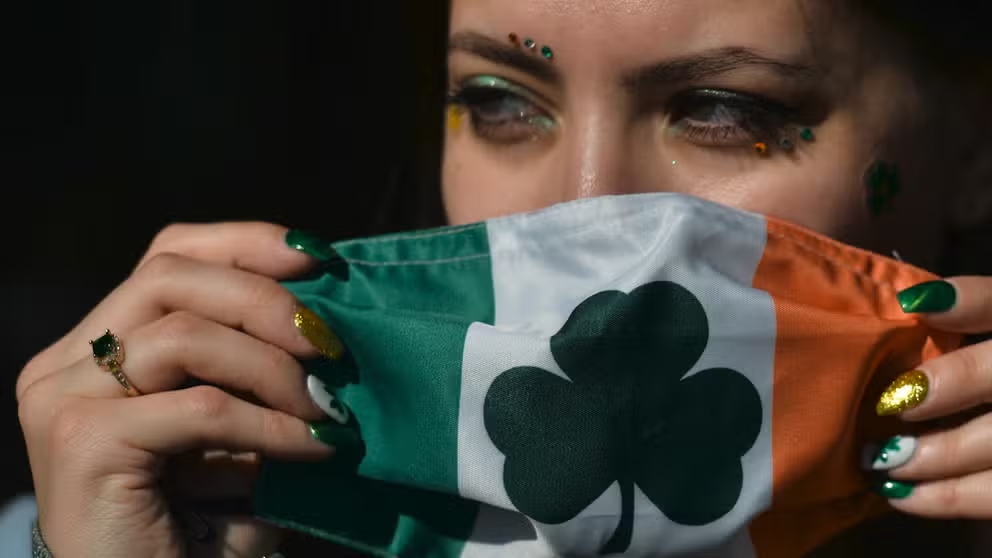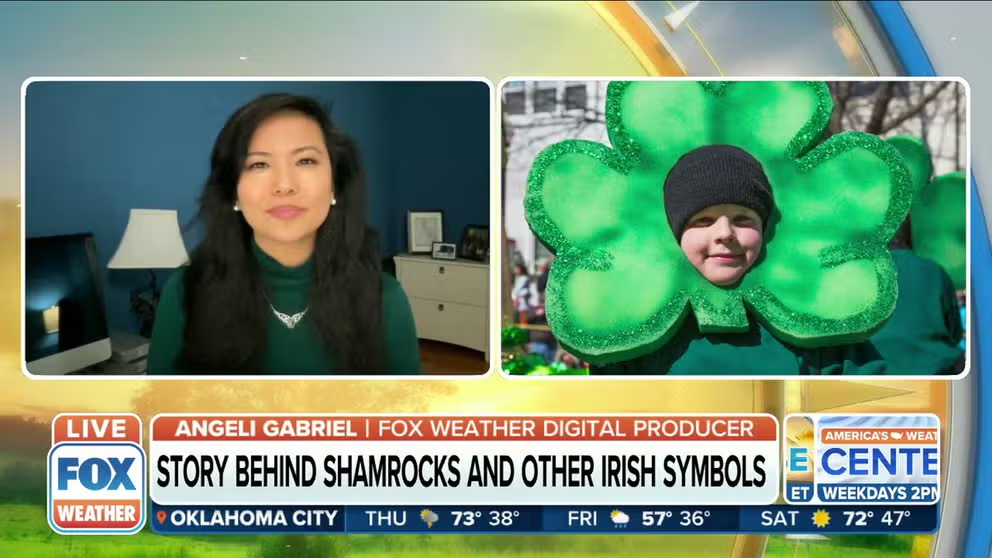The true story behind shamrocks and other Irish symbols
What can appear to be simple lucky charms and trinkets can hold much deeper meanings, even as they evolve over time. Here is the story behind shamrocks, leprechauns, rainbows and other symbols of luck.
7 Irish symbols explained
The true story behind shamrocks and other Irish symbols.
Elements of Irish culture have become synonymous with luck, particularly with symbols such as shamrocks, rainbows and horseshoes. However, there’s more to the story of these Irish symbols or "lucky charms."
The prevalence of these Irish symbols is largely rooted in the immigration of Irish men and women to the U.S. in the 19th century – and with them, came symbols of their culture.
As some Irish symbols began to proliferate in the U.S., with meanings that remained true to Irish traditions, others underwent some significant changes.
Here are a few examples of Irish symbols and sayings associated with luck.
1. The luck of the Irish
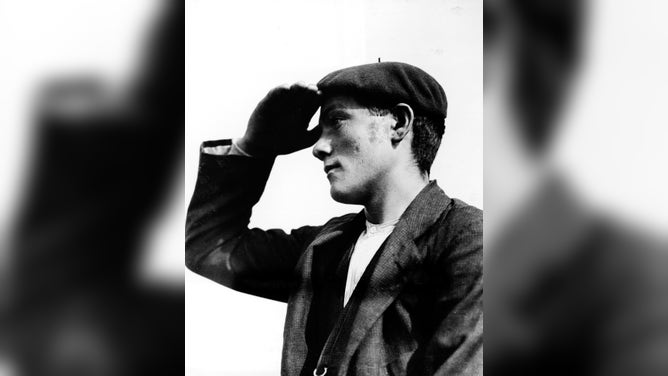
An Irish immigrant wears a beret and shields his eyes in order to catch a glimpse of New York City across the harbor, Ellis island, early 20th Century.
(FPG / Getty Images)
A phrase popularly associated with Irish luck has some dark origins.
"The phrase ‘The luck of the Irish’ was actually not saying that we had good luck, originally — it was saying that we had bad luck," said Elizabeth Stack, executive director of the Irish American Heritage Museum in Albany, New York.
For example, Stack said many Irish laborers experienced high fatality rates while on the job during the Gold Rush.
Despite the irony of "The luck of the Irish," the phrase morphed over time and gained a literal meaning of good fortune. Additionally, many symbols from Irish culture became considered lucky, as well.
2. Shamrocks
The story behind shamrocks and other Irish symbols
Angeli Gabriel, Digital Content Producer for FOX Weather, explains Irish myths and traditions involving luck, such as a pot of gold at the end of a rainbow, leprechauns, and four leaf clovers for St. Patrick's Day on March 17.
One symbol that is often considered lucky is the shamrock. The luck of this tiny, bright green plant, however, may have involved a bit of a mix-up, according to Stack.
"An unofficial official symbol, if you like, of Ireland is the shamrock, but I think sometimes it gets confused with the four-leaf clover in terms of that luck element," she said.
The significance of the three-leafed shamrock comes from St. Patrick himself. He used the shamrock to describe the three forms of God – the Father, Son and the Holy Spirit – to convert early Irish people to Christianity.
HOW ST. PATRICK'S DAY BECAME A POPULAR HOLIDAY
Despite the role played by the shamrock, the four-leafed clover took over as a symbol of good luck.
3. Leprechauns and pots of gold
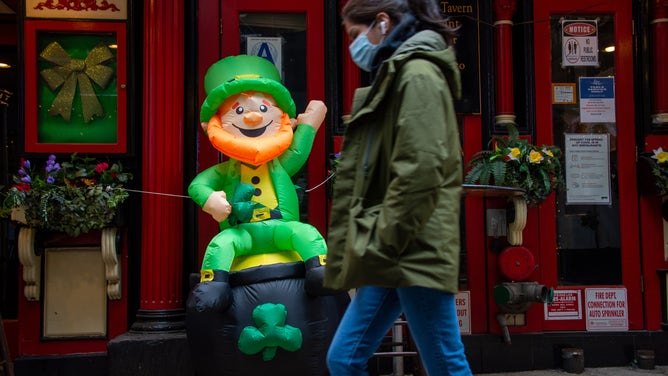
An inflatable leprechaun greets a passerby.
(Alexi Rosenfeld / Getty Images)
Another Irish symbol that’s said to have lucky origins is the leprechaun.
According to Stack, the leprechaun may be connected to the ancient Irish belief in fairies, otherworldly creatures that live alongside humans. The leprechaun would have been one of many classes of fairies.
"I think the leprechaun was kind of seen as maybe a more marketable one," Stack said, using the Notre Dame mascot as an example.
IRISH STEP DANCING WITH IONA UNIVERSITY IRISH DANCE TEAM
"The symbol got picked up quite quickly," she added. "Part of the allure of the leprechaun is, of course, if you can catch him, that he has a crock of gold at the end of the rainbow. So these are, I think, more invented symbols that came a little bit later."
4. Rainbows and horseshoes

Colorful arc of a rainbow during a summer storm.
(Jim Lane / Education Images / Universal Images Group / Getty Images)
The rainbow, often associated with Irish luck, doesn’t bear any auspicious meanings in Irish culture either.
"I don't know that Irish people in Ireland have any particular affinity with the rainbow," Stack said. "I mean, we love it when they come."
"Part of me thinks it’s more of this coming from Lucky Charms and that kind of marketing sort of strategy than actually something that was organic to the community themselves," she added.
However, one Irish symbol of luck remains true: a horseshoe, with its U-shape serving as a vessel for holding luck.
"That seems to be an ancient tradition," Stack said. "A lot of Irish families have a horseshoe over the door, and you would turn it up so that the luck stays inside, not upside down."
5. Harps
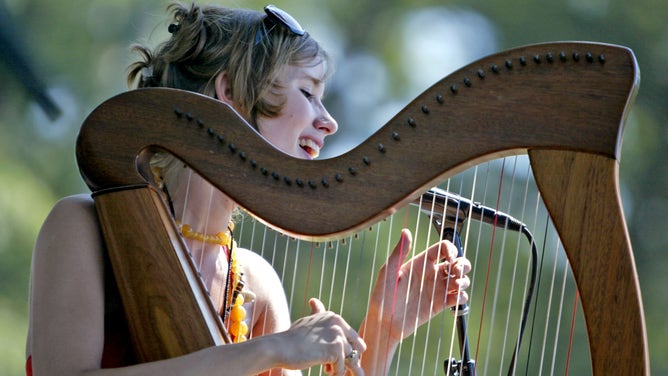
Harpist as the Irish Cultural Centre in Canton, MA.
(David Goldman / MediaNews Group / Boston Herald / Getty Images)
Despite the adoption and morphing of some Irish cultural elements of "luck," other elements of Irish culture have gained popularity in the U.S. while remaining true to their original Irish origins.
Harps -- found anywhere from concert halls to labels of a specific Irish beer enjoyed on St. Patrick’s Day -- are quite central to ancient and modern Irish traditions.
According to Stack, in medieval times, harps were played by musical poets called bards.
HOW THE WEATHER CAN CHANGE THE SHAPE AND SOUND OF MUSICAL INSTRUMENTS
"The musicians were very, very key to Irish culture," she said. "They were often associated with certain chieftains or clans. It was absolutely imperative that your court had a bard who could play the harp, and so they would recite these great long poems in honor of their patron."
According to Stack, Ireland is the only country with a musical instrument as its national symbol.
6. The Claddagh ring
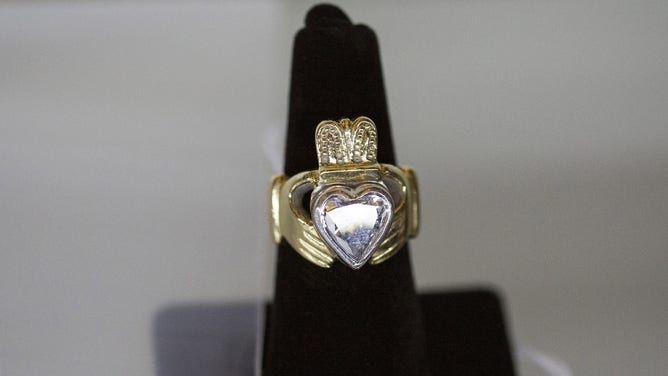
A claddagh ring on display.
(Scott Eisen / Bloomberg / Getty Images)
Another popular Irish symbol in the U.S. is the Claddagh ring, which was designed by Irish artist Richard Joyce in the 17th century.
"It's very popular as a wedding ring," Stack said. "It's basically a heart that has a crown over it and then two hands hold it together. So it's supposed to represent love and loyalty."
She noted that the two hands are of Dagda, the father of the Celtic gods, and Anu, a mother goddess who is a goddess of love.
7. The Trinity knot
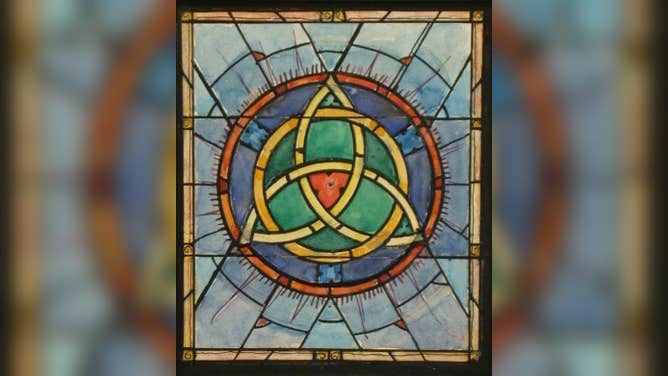
A design drawing for a stained glass window with a Celtic trefoil knot.
(Library of Congress / Getty Images)
Another symbol with ancient roots remains strong in Irish American culture – the Irish, or Celtic, knot.
"Sometimes these are called the Trinity Knot, but it was basically to symbolize the Celtic belief in eternal life infinity," Stack said.
"There's, you know, an intermingling between the relationship with the divine and nature, and also the trinity between heart, soul and mind or the body, mind and spirit," she added. "So, those ancient symbols have kind of aggressed through new age thinking, now in spirituality."
"I think that's why they're so popular today -- that interlinking of the three endures."
The significance of Irish symbols in American culture

A St. Patrick's Day parade spectator wears a golden shamrock painted on her cheek.
(Drew Angerer / Getty Images)
Enduring the passage of time and the seemingly inevitable changes that come with it can be a challenge for any culture — who knows what kind of future the early Irish immigrants saw for their culture in the U.S.?
"These symbols were something that was easy to bring with you," Stack said.
"It was to the ancient symbols that they looked so that they could try to keep them going and generate a love in this country for Irish language, but also Irish culture and music. And those symbols just helped to kind of propagate that."
Today, many of those symbols seem ubiquitous, having spread throughout many aspects of American life in addition to specifically Irish American culture.
"I suppose in a way that's the ultimate sign of acceptance," Stack said. "I think it must be very heartwarming for Irish Americans to see other people want to use them or to see how popular they have become because it means that you have transcended the difficulty."
HOW TO WATCH FOX WEATHER ON TV
"So, something that maybe you wore furtively, or you wore with pride, which you were afraid of showing it, now you can absolutely wear it with pride and be happy to share with the world and encourage."
